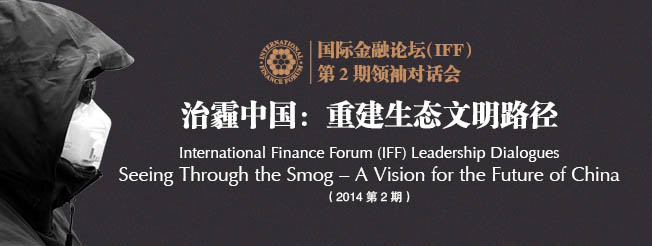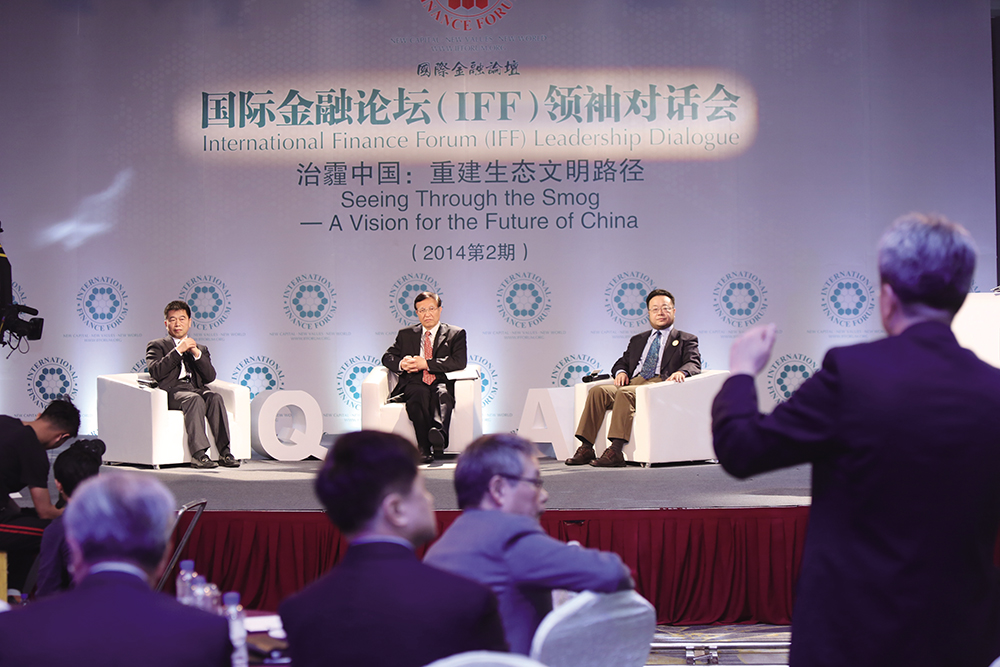IFF 2nd Leadership Dialogue: Seeing Through the Smog—A vision for the future of China
AUTHOR:IFF
FROM:IFF
TIME:2014-03-28

The second IFF Leadership Dialogue has been successfully held in Beijing on March 25th with the theme, "Seeing Through the Smog—A vision for the future of China." At the event, Cheng Siwei, Chairman of IFF; Jin Liqun, Executive Vice President of IFF and Secretary-General of Multilateral Interim Secretariat for Establishing Asian Infrastructure Investment Bank and Zhang Guobao, Director of the Expert Committee of the National Energy Commission were invited as the Keynote speakers. Industry experts and technology elites had concrete discussions on China's economic transformation on pollution and smog and explored optimal methods for their mitigation. IFF also proposed to launch China's first Clean Air Fund.
Agenda

Against the backdrop of China's new reform and economic restructuring, ecology, energy and climate have become the country's top priorities. People began to ask "how can we make real progress in air pollution, and how we rebuild the path to a more ecological society?". Leadership of IFF and all guests launched the ceremony of IFF Clean Air Fund.
The Report on the Work of the Government 2014 stated that, "We will fully implement the plan for preventing and controlling air pollution, with focus on mega cities regions with frequent occurrences of smog. We will start by reducing the PM10 and PM2.5 emissions, and focusing on the following key areas: improving the industrial structure, raising energy efficiency, reducing vehicle exhaust emissions, and preventing and monitoring wind-borne dust. We will improve the new mechanism involving the government, enterprises and the general public, coordinate prevention and control efforts in affected regions, and fully implement the action plan for preventing and controlling air pollution. We will declare war against pollution and fight it with the same determination that we used to battle poverty. "
We comprehensively interpreted the new policy released on NPC and CPPCC in 2014 and explored how to integrate policy, capital and technology transparently and efficiently, to promote national and the social cooperation in effectively dealing with the problem of Chinese haze.
As the widespread smog continues to damage our respiratory systems, it has simultaneously fueled the market demand for smog mitigation industry. In the next decade, China will tighten regulations and increase investment in green technologies and infrastructure. By 2015, the total value of environmental industry will reach 4.5 trillion RMB and become a new pillar of China's economy. While the haze crisis has brought challenges, it is also accompanied by opportunities. The panel further discussed how investments would serve an eco-friendly society and maintain sustainability while promoting economic growth in an inclusive, fair, transparent and efficient environmental industry.
Viewpoints
Some people believed that the development of China must be based on growth in urbanization, real estate and practical elements such as iron and steel, thermal power, cement, and plate glass, etc. Then it is impossible to relive pollution in the short term. Others regard environmental risk management as extra cost and thereof feel reluctant to prevent pollution. How to address these disputes? What are the suggestions?

First, it is a vicious circle to curb environmental pollution only after it happens. We have to face the existing problems and try to maintain healthy environment one step ahead before it is polluted.
Second, the idea of sacrificing GDP to alleviate pollution is a fallacy.
Third, we absolutely cannot take GDP as the only or the primary index in the assessment of government leaders. To clear the haze, we should establish correct values in our mind first.
The haze problem in China can be manifested in two aspects: one is the absence of government function; second is the lack of universal participation. How can we make some improvements in these areas?

In the past, we attached much importance to economic growth than environmental protection. The government now should give top priority to environment governance and perfect the corresponding system at the same time. The Third Plenary Session of the 18th CPC Central Committee has put forward the source-controlling system, the compensation system and the responsibility investigation system. The source-controlling system is the key, while the other two function as legal deterrence. Therefore, only by combining these three systems together can they truly function well.
To upgrade the economic growth model and mitigate air pollution, we need to develop a model with slower economic growth. But how do we explain the fact that no changes happened in the GDP-oriented operation and growth model?

I understand why the government targets high GDP. And I also understand the dilemma for our government. How do we solve the problem? First, the GDP growth rate should be adjusted to a reasonable level. Second, understanding and support from the public is needed.
In terms of solving the problem of air pollution, what advantage has the energy price reform brought to us?

First, the price of energy needs to be adjusted in a modest way, so that people have time to adapt.
Second, clear elaboration and explanation needs to be provided with the price adjustment. I believe most Chinese people can understand it if our government can be transparent, fair and can improve their management capacity.
First, how to implement China's top design, namely the proposal by the central government, in local places? And how should local governments react if the goal of emission reduction and energy saving is not achieved?
Second, how to manage the SOEs with outdated capacity? It is hard to truly supervise, assess or even shut down these enterprises.

Economic growth are influenced by many factors, which are sometimes controversial, such as economic growth, inflation, employment, and environment, etc. We should put the environmental issues in priority since environmental protection is one of our fundamental national policies. But the announcement of policy does not always guarantee smooth implementation. Leaders from all levels of governments need to truly change their old mindsets and put the environment protection before GDP growth or any other issues. Meanwhile, they need to arouse the awareness of environment protection as a national policy. It is far from enough to merely have ideas and regulations.
Who should formulate the standards for "Mitigate haze in China", the government or the third party institutions? Who will have the final say on of the result of "Mitigate haze in China" as a success or a failure?

Technically, the standard of "Mitigate haze in China" is the standard of air quality, which is formulated by China's environmental protection department. The definition of haze is directly linked with air quality standard of PM2.5, according to national standard. As for the "supervisors", there are at least two criteria. First, the concentration of PM2.5, which is monitored by scientific methods and apparatus; second, originally a natural meteorological phenomena, the haze is directly linked with visibility. Therefore, the haze can be monitored either by scientific data or our naked eyes.
What is the main cause of haze? Which industries can cause so much pollution?

Simply speaking, the internal cause of haze is emission while the external cause is meteorology. The latter itself is a natural condition. Regarding emission reductions, on the other hand, some of the policies, regulations and technical measures over the past thirty years have slowed down the growth rate, but not the growth trend, which is one of the fundamental reasons for today's pollution. In short, the emission is accompanied with all kinds of production and life activities. Across the country, coal combustion ranks as the first reason of haze, motor vehicles the second and industry the third, followed by the dust caused by all kinds of buildings and traffic.
How convincing is the present data related to air quality?

We cannot guarantee that the data of each part of the nation are true, but the data of Beijing, which is under the supervision of the whole world, is guaranteed. Clean air is described as below 100, which is within the national secondary standard. Further, below 50 is excellent; 50 to 100 is good; 100 to 150 is slightly polluted; 150 to 200 is mildly polluted; above 200 is severely polluted.
How does the government guide the funds, including industrial funds and private capital to invest and manage output?

To control haze needs the promotion of not only the government, but also the invisible hand of the market. The haze-mitigation industry needs the common efforts of the government and civil society: we should not only attach enough importance to the environmental protection industry in terms of national funds, but also pay attention to the determination and responsibility of enterprises to mitigate haze. We should control the haze with regard to its causes.
Technically, PM2.5 refers to the particles below 2.5 micron. What does "500" mean?

PM2.5 is a concept regarding the diameter of particles, which is an inclusive concept rather than exclusive. In other words, PM10 includes PM2.5 and PM2.5 includes PM2.5 and all the smaller particles. The concentration value of 500 means that 500 micrograms of particles below PM2.5 in a cubic meter of air.